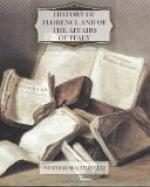who, contrary to the wish of some of his neighbors,
intended to turn a watercourse into his estate; but
that before they went they wished to take leave of
the prince. They also assembled, under various
pretenses, other friends and relatives, trusting that
when the deed was accomplished, everyone would join
them in the completion of their enterprise. It
was their intention, after the duke’s death,
to collect their followers together and proceed to
those parts of the city where they imagined the plebeians
would be most disposed to take arms against the duchess
and the principal ministers of state, and they thought
the people, on account of the famine which then prevailed,
would easily be induced to follow them; for it was
their design to give up the houses of Cecco Simonetta,
Giovanni Botti, and Francesco Lucani, all leading men
in the government, to be plundered, and by this means
gain over the populace and restore liberty to the
community. With these ideas, and with minds resolved
upon their execution, Giovanandrea, together with
the rest, were early at the church, and heard mass
together; after which, Giovanandrea, turning to a
statue of St. Ambrose, said, “O patron of our
city! thou knowest our intention, and the end we would
attain, by so many dangers; favor our enterprise,
and prove, by protecting the oppressed, that tyranny
is offensive to thee.” To the duke, on the
other hand, when intending to go to the church, many
omens occurred of his approaching death; for in the
morning, having put on a cuirass, as was his frequent
custom, he immediately took it off again, either because
it inconvenienced him, or that he did not like its
appearance. He then wished to hear mass in the
castle, and found that the priest who officiated in
the chapel had gone to St. Stephen’s, and had
taken with him the sacred utensils. On this he
desired the service to be performed by the bishop
of Como, who acquainted him with preventing circumstances.
Thus, almost compelled, he determined to go to the
church; but before his departure, caused his sons,
Giovan Galeazzo and Ermes, to be brought to him, whom
he embraced and kissed several times, seeming reluctant
to part with them. He then left the castle, and,
with the ambassadors of Ferrara and Mantua on either
hand, proceeded to St. Stephen’s. The conspirators,
to avoid exciting suspicion, and to escape the cold,
which was very severe, had withdrawn to an apartment
of the archpriest, who was a friend of theirs, but
hearing the duke’s approach, they came into
the church, Giovanandrea and Girolamo placing themselves
upon the right hand of the entrance, and Carlo on
the left. Those who led the procession had already
entered, and were followed by the duke, surrounded
by such a multitude as is usual on similar occasions.
The first attack was made by Lampognano and Girolamo,
who, pretending to clear the way for the prince, came
close to him, and grasping their daggers, which, being
short and sharp, were concealed in the sleeves of




